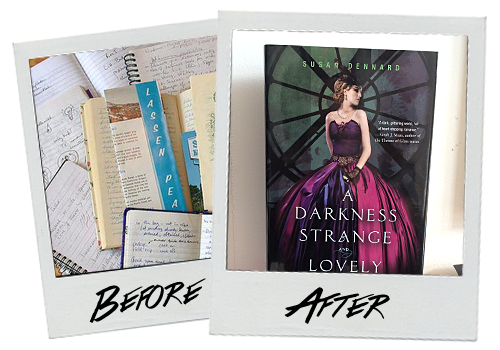After Editing: Finding the “Right Story” In Your Draft

The “Now What?” Months are here to guide you through the editing, revision, and publishing processes! Every novel is the “after” picture to the first draft’s “before”. Today, Susan Dennard, author of the Something Strange and Deadly series and the forthcoming Truthwitch, tells us how she discovered the Right Story hidden in her draft.
The first draft: Every year, I write at least one new manuscript. And every year, I’m faced with revising that manuscript into something that’s not only readable, but good enough for publication.
That is totally easier said than done.
You see, I’m a just-get-the-words-out-as-fast-as-you-can sort of writer, and I view my first draft as an exploratory one. Needless to say, the end product is… well… messy. With my most recent completed novel, Truthwitch, I’d learned to embrace the mess. I knew myself well enough to understand that revisions were where the “magic” would really happen…
No joke: writing almost breaks me every time, but I love (100% all-caps LOVE) revising. Like, I wish I could somehow skip that whole drafting nonsense and just get straight to the revisions part of it all.
So, I word-vomited my way through an exploratory draft of Truthwitch, and then—oh, then I dug into the revising.
The makeover: Now, my first step for revisions on any project is to figure out the Right Story. What was the story I actually wanted to tell versus what I wrote, and how can I fix my characters, plot, setting, etc. to reflect that Right Story?
For Truthwitch, I found I had some major holes—like, entire scenes missing, character arcs that changed trajectory mid-book, or an entire subplot that just felt wrong, wrong, wrong upon reading (but gosh, it felt so right at the time of drafting! In fact, I’m pretty sure I thought I was brilliant as the words tumbled forth).
Still, the bones of Truthwitch’s story were there, and once I’d figured out exactly how I wanted the story skeleton to look, then I was able to begin the actual revisions process.
I happily dove in, hacking away for a month—word by word, scene by scene—until I’d rewritten, revised, and ultimately transformed my initial heap of word-vomit into something resembling a Real Story.
Of course, I might’ve had a cohesive story, but the book was still far from readable. So, I moved onto smaller issues next—the scene-level things like tension, dialogue, pacing, and prose. Because the book was huge (like, 160,000 words huge), this step took me several rounds over the course of a month—and even after that, I still wasn’t finished.
Nope, I was at Round 3, which (for me) means passing off my book to critique partners. I do this with every book I write, and Truthwitch was no different. Except…womp-womp. My critique partners feedback was rather harsh. It would seem the voice turned wonky halfway through the book, and without even realizing it, I was suddenly skewing much too young—almost middle grade in a book that was meant to be upper young adult.
So, after cuing up “Eye of the Tiger,” I dove back into Truthwitch and rewrote it! Again! Hooray!
(I was so not saying “Hooray” at the time, by the way.)
The final product: No matter my emotional state during those few weeks of rewriting, though, ripping apart the book was absolutely necessary. Because telling the Right Story is my end game—always—and it’s worth some extra months of hair-pulling to ensure my editor (and my readers!) get the best possible product.
So the moral of my Truthwitch revisions tale is pretty simple: don’t settle and don’t rush. Revisions are your chance to transform a so-so book into a great one—or a great book into an incredible one. All that work can seem daunting (trust me, I know!), but if you tackle a little bit everyday then, you’ll soon have a polished product ready for external eyes.

Susan Dennard has come a long way from small town Georgia. As a marine biologist, she got to travel the world, and now she’s the author of the Something Strange and Deadly series (HarperTeen) and the Witchlands series (Tor, 2015). When not writing, she can be found hiking with her dogs, earning bruises at the dojo, or practicing her tap dance shuffles. You can learn more about her crazy thoughts and crippling cookie-addiction on her blog, newsletter, Twitter, Facebook, or Pinterest.
Notes
 queenofthenetherlings reblogged this from stdennard
queenofthenetherlings reblogged this from stdennard itsinherited liked this
cjs-penetralia liked this
 kykylovesthg liked this
kykylovesthg liked this alurea-actually-a-prince liked this
waterwitchbabes-blog liked this
morelikegaywaren-blog liked this
jukeboxsweet-heart liked this
claireandrewslit reblogged this from stdennard
connors-glorious-manboobs liked this
luciastella reblogged this from stdennard
isadeltstuff reblogged this from nanowrimo
maxisthenewalex liked this
secretcupcakesong liked this
hungry-sleepy-cloud-blog liked this
xstardustyx-blog liked this
violet1865 liked this
averysangel reblogged this from nanowrimo
wordscannotlie liked this
celaenadeathvow liked this
draconunquamdormiens liked this
fictionandfuckery reblogged this from stdennard
fictionandfuckery liked this
 curvycouplewithcamera liked this
curvycouplewithcamera liked this kimberlysueiverson reblogged this from nanowrimo
kimberlysueiverson liked this
ery4326 liked this
 firewordsparkler liked this
firewordsparkler liked this ofbooksandbaking reblogged this from nanowrimo
thebookdevourer reblogged this from nanowrimo
 chimeracandor liked this
chimeracandor liked this min-d-palace liked this
espaces-entre-mots reblogged this from nanowrimo
chasingriversong reblogged this from nanowrimo
twentyninepointfive liked this
writerlacenelson reblogged this from faindri
 hfin01 liked this
hfin01 liked this brastrophobia liked this
geniusorinsanity reblogged this from nanowrimo
thegoldensnitches reblogged this from stdennard
writerlacenelson liked this
 supremekhaleesi-blog liked this
supremekhaleesi-blog liked this nanowrimo posted this
- Show more notes
